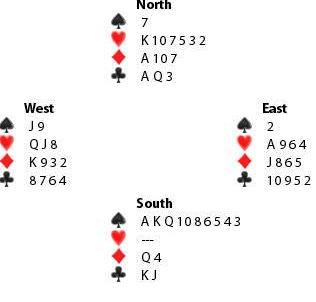Source: www.ronklingerbridge.com
Three deals came up for discussion from last night’s session:
East dealer : East-west vulnerable

How should East-West bid to reach 6NT?
If playing a strong 1NT, the bidding might go 1NT : 2![]() , 2
, 2![]() : 4NT (inviting slam), 6
: 4NT (inviting slam), 6![]() : 6NT. If partner invites game or slam, always accept with a good 5-card suit. East bids 6
: 6NT. If partner invites game or slam, always accept with a good 5-card suit. East bids 6![]() to suggest slam in diamonds, but with only doubleton support, West reverts to 6NT.
to suggest slam in diamonds, but with only doubleton support, West reverts to 6NT.
With diamonds 4-2, you have eleven tricks. A heart lead would give you the twelfth. On a non-heart lead you can create an extra trick in clubs. In fact the ![]() Q was onside and so thirteen tricks were available. Only two pairs reached 6NT, the others played in 3NT.
Q was onside and so thirteen tricks were available. Only two pairs reached 6NT, the others played in 3NT.
Consider the West hand above. How would you proceed if the bidding began 1NT : 2![]() , 2
, 2![]() or 1NT : 2
or 1NT : 2![]() , 2
, 2![]() . We play that 4NT in each of these actions is not Blackwood, but is quantitative, inviting opener to bid on to slam if maximum. After 1NT : 2
. We play that 4NT in each of these actions is not Blackwood, but is quantitative, inviting opener to bid on to slam if maximum. After 1NT : 2![]() , 2
, 2![]() we play that 3
we play that 3![]() sets hearts as trumps and asks opener to cue-bid (what other useful purpose would 3
sets hearts as trumps and asks opener to cue-bid (what other useful purpose would 3![]() have?), while 1NT : 2
have?), while 1NT : 2![]() , 2
, 2![]() : 3
: 3![]() sets spades as trumps and starts cue-bidding. After that, responder can use 4NT to ask for key cards or aces. That approach leaves 1NT : 2
sets spades as trumps and starts cue-bidding. After that, responder can use 4NT to ask for key cards or aces. That approach leaves 1NT : 2![]() , 2
, 2![]() /2
/2![]() /2
/2![]() : 4NT available as quantitative.
: 4NT available as quantitative.
Suppose the bidding starts:
North dealer : East-West vulnerable
What should East do with:

Assuming you take 4![]() as natural, you can deduce partner does not have two spades (would have supported spades), will have five hearts (East’s jump to 3
as natural, you can deduce partner does not have two spades (would have supported spades), will have five hearts (East’s jump to 3![]() denied four Hearts) and hence will also have 6+ diamonds (since the diamonds were bid ahead of the 5-card heart suit). With your excellent support for partner’s red suits, is it far-fetched to expect East to jump to 6
denied four Hearts) and hence will also have 6+ diamonds (since the diamonds were bid ahead of the 5-card heart suit). With your excellent support for partner’s red suits, is it far-fetched to expect East to jump to 6![]() over 4
over 4![]() ? That was the winning spot, found by only one pair.
? That was the winning spot, found by only one pair.
West held: In fact thirteen tricks were easy.
In fact thirteen tricks were easy.
A 9-card suit is a great rarity (about one in 10,000 deals), but one came up in last night’s session:
Board 4: Dealer West : Both vulnerable

7![]() is available, but very tough to reach. In practice five pairs played in 6
is available, but very tough to reach. In practice five pairs played in 6![]() , while five stopped in 4
, while five stopped in 4![]() . Thus, even reaching 6
. Thus, even reaching 6![]() was a shared top. Once North opens 1
was a shared top. Once North opens 1![]() , South knows that slam is possible, but for South, the difficulty lies in making sure that the diamond suit is controlled (North could have A-K in hearts and nothing in diamonds). Even if you can determine that, can you find out that North has the
, South knows that slam is possible, but for South, the difficulty lies in making sure that the diamond suit is controlled (North could have A-K in hearts and nothing in diamonds). Even if you can determine that, can you find out that North has the ![]() A and not the
A and not the ![]() A and that North has
A and that North has ![]() A-Q-x (and not A-Q doubleton) so that you can discard your diamond loser on the third round of clubs. It is all very, very hard.
A-Q-x (and not A-Q doubleton) so that you can discard your diamond loser on the third round of clubs. It is all very, very hard.
